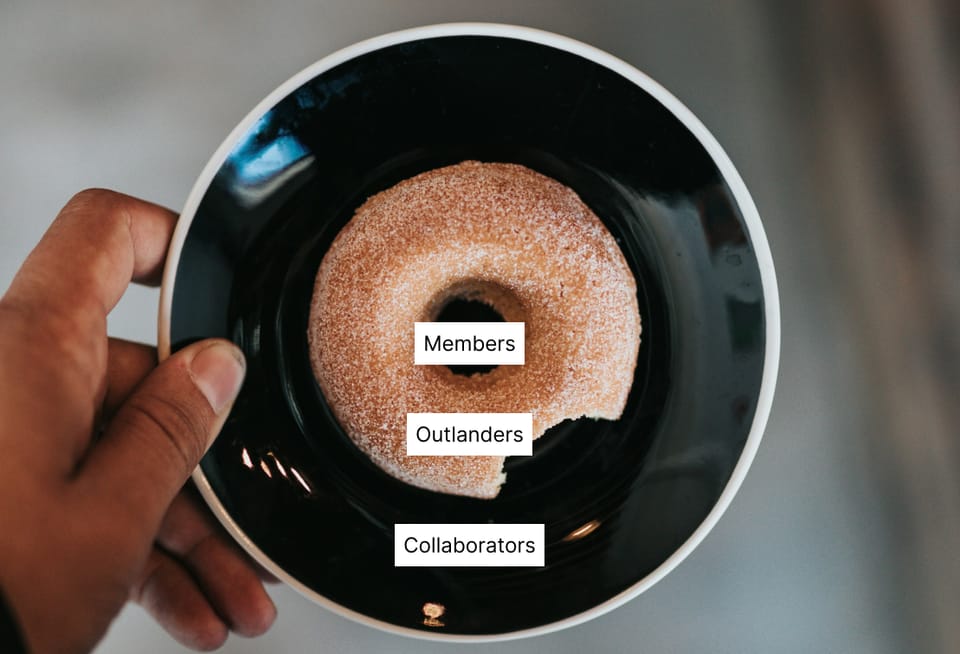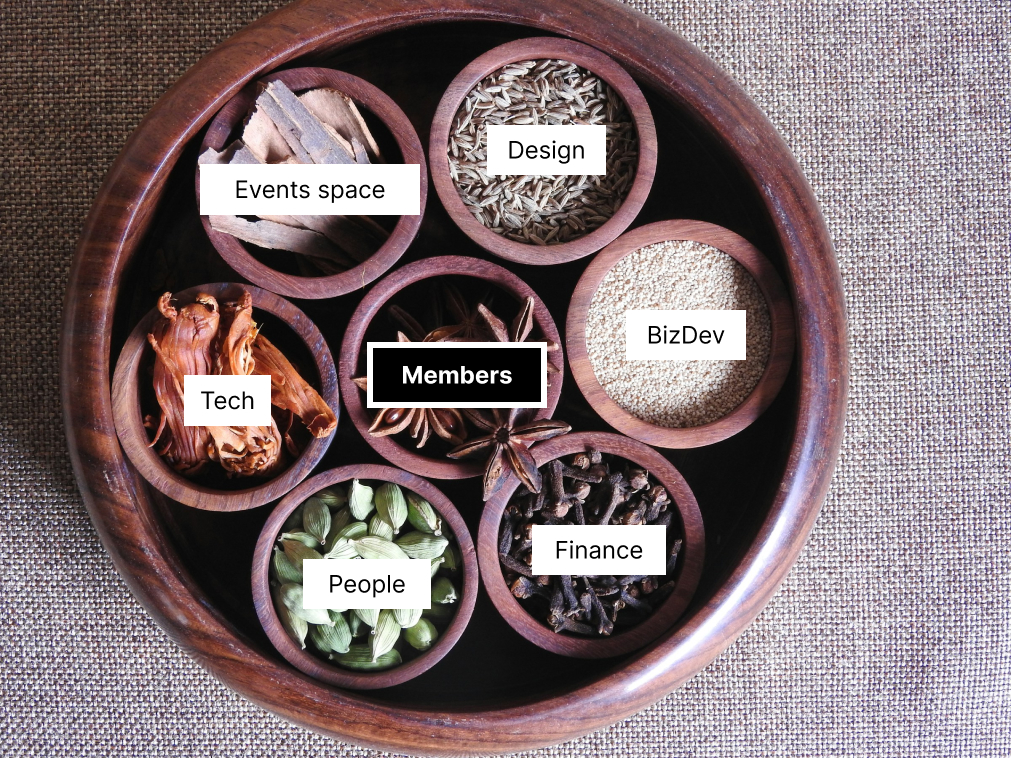How we run our tech company flat, without hierarchy

I’ve talked about this many times in person but never in writing: how we run our company flat - without hierarchy, managers, or anything like that.
That’s not to say that we don’t have structure, we do. But there’s no upwards reporting or supervision. And it works for us. It helps us feel empowered, independent and productive.
Thanks for reading Without Constraints! Subscribe for free to receive new posts and support my work.
Outlandish the Company
At Outlandish, we make websites and data tools for social impact organizations. But the important thing to note is that we’re a worker-owned cooperative; there are no shareholders or anyone else extracting value from the company.
As a cooperative, all employees are co-owners/co-directors of the company. And, of course, as employees, the company pays our income taxes, contributes to our pensions, and provides all the usual benefits of being an employee in a business..
Being a cooperative isn’t a requirement for flat-structure companies - I think pretty much everything I’m about to explain can be applied to non-cooperative businesses - but it’s an ethos that aligns well with the structure we employ, and underpins its core practices.
Okay let’s get into it.
Structure 1: The People
To talk about structure at Outlandish is to talk about the people. And we’re all organized into circles; three of them, to be precise. These circles are arranged concentrically, one inside the other.

- Innermost Circle: Members
The innermost circle represents the “Members,” what we call the employee-owners of the business. They are involved in project delivery as developers, designers, project managers and more. But Members also have legal responsibility for the business and make important business-critical decisions about finances, strategy, hiring, and other key areas. - Outermost Circle: Collaborators
Collaborators are trusted freelancers with whom we regularly work. Their focus is primarily on project delivery rather than internal business operations, but they are still involved in some of the internal teams and decision making. - Middle Circle: Outlanders
And in the middle we have Outlanders. Outlanders are freelancers who are increasingly interested in helping run the business. They’re attending some business decision-making meetings and taking on more internal work, and gradually moving toward becoming Members.
Status
From these circles, you’ve probably gleaned that there is some form of status at Outlandish.
And that’s true; even though we are flat and non-hierarchical, there are roles and statuses. This is discussed most when we consider who gets to work on what.
Generally, Members are to be offered work first, followed by Outlanders, and then Collaborators. In other words, work radiates outwards from the central circle.
Now, the reality is that things don’t quite work like this in practice, for a number of reasons. Partly because everyone's got different skills, and when work comes through the door it’s sometimes obvious that a Collaborator is best suited for it over a Member. Or they have more availability to take it on than a Member, or whatever.
Also, we care about our friends at work, and we want them to be able to pay their bills and lead happy lives too, so we don’t like to horde work to Members only.
So any status at Outlandish is mild, and the flow of work doesn't happen according to strict rules. But in short the company exists to serve the Members, meaning there is a gentle and benign influence helping Members - who ultimately carry the legal responsibility of running the company - get the first choice of work. It also acts as an incentive for people to consider becoming Members..
Structure 2: Teams in Circles
Flatness at Outlandish is also created in the way that the teams are organised and how they intersect. I.e. not vertically, but horizontally.
Each team, serving a specific business function such as finance, business development, design, tech etc, is also called a “circle.” (Yes, there are all kinds of circles!) Additionally some larger projects, like our coworking and events space SPACE4, also have their own circles.
And each circle should have at least two Members, ensuring all circles intersect with the Member Circle.

Circles are self-organizing…
These circles are very self-organizing and self-empowered. Anyone can join a circle by bringing a proposal (supported by a Member) in which they outline the value they would bring to that circle. This proposal is then checked by - and potentially agreed to - by the participants of the circle. (Of course there needs to be budget available to accommodate a new participant too).
In this way Members, Outlanders and Collaborators are free to join and contribute to the work of any area of the business. You’re a project manager but you want to join the finance team and learn about doing month end accounts? Great - bring a proposal and the team would be glad to have you.
Circles are self-empowered
Circles are empowered to make decisions and perform their work independently. We do this by practicing sociocratic decision-making within each circle. This means people bring proposals (e.g. a proposal to increase our client fees), and then these are discussed to tease out questions and check for “consent” to proceed.
What’s consent? Well, it’s not consensus, that’s for sure. We don’t aim for everyone to agree this what is being proposed is the best idea. Instead we ask everyone, is this proposal “good enough for now and safe enough to try”. In other words, can each of us consent to giving it a go?
This approach ensures continuous progress, and if something doesn’t work, we adapt with a new proposal and a new approach. This not only creates self-empowered teams but fosters a lot of personal empowerment too - because anyone can bring a proposal.
(And if you’re developing tech like we do at Outlandish, this practice aligns really well with some of the key tenets of Agile software delivery: that development teams are self-organizing, choose best how to accomplish their work, and adapt as they go.
This Sounds Great. What’s the Catch?
I’m not going to lie, running a flat company is difficult. Issues of power and responsibility remain, even in a structure designed to be egalitarian.
One of the challenges we’ve faced at Outlandish is maintaining flatness without set responsibilities. We don’t have people with roles dedicated solely to tasks like finance or HR; instead, a developer might also handle month-end finances or help with business development.
And the absence of set roles can create complications.

Freedom to work vs. the needs of the business
Firstly, some people naturally gravitate towards delivery work rather than the running-the-company work.
At Outlandish, where we blend roles and everyone is free to consent to work (rather than it being foisted upon them), this preference can become a challenge. For example, if a developer prefers to focus on coding, and they're free to do that and decline the internal work, it means someone else has to pick up the internal tasks. And this has been known to cause resentment.
Personally, I think we don’t make it easy on ourselves. In my opinion, members of the team who focus purely on client work are still delivering great value to the company in the form of delivered work, happy clients, and a decent margin so that we can keep on going.
The division of labour and accountability is something that we still need to work out. But then perhaps that’s the trade-off with trust and flexibility? 😉
Peaks and troughs
Secondly, because we don’t have anyone in the Member or Outlander groups who solely works on either internal or delivery work, our current practice means that important team members are forever switching between client work (which brings in income, but takes our eyes off the ball of maintaining the business) and internal work (which needs to be done, but doesn’t bring in income).
This can cause frustration, sure, but worse it can create ‘peaks and troughs’ of income or internal spend which create a financial rollercoaster. For example, peaks when we are all heads-down and rushing to deliver client work.
This seems great - income is coming in, and we’re delivering on our mission to deliver great projects for positive social impact. But, when the work is all delivered, come troughs: because we were distracted from investing in securing new work for the future. And at this point we all switch to securing new work, and the spend on our internal work ramps up.
And so the cycle continues!
Indispensability
And the third issue is that there are those of us who enjoy organizing and running a company. They bring passion and ideas, sometimes taking on leadership roles in multiple circles. While their contributions are invaluable, and despite everyone’s best intentions, in the long run this can unintentionally create problems of power: these people can become indispensable to business-critical functions and are seen as holders of knowledge.
In the best case scenario this means that they can become bottlenecks for checking business critical decisions. In the worst case (and we’re glad this hasn’t happened at Outlandish, but it can happen at other cooperatives) they can have more status and importance than others. This risks un-flattening the structure.

Phew! This has turned into a long post…
You can see why I haven’t written it all down before! It’s certainly easier to explain in person, laying it out over a coffee or in a side-conversation at one of our events (plug).
Let me just finish on a positive note.
Because despite the issues and risks above, our flat structure company at Outandish helps make it the greatest place I’ve ever worked. Because, whilst the structure introduces challenges, it also helps foster an empowering and inclusive environment. I’ve never had as much control, self-fulfilment and friendly working relations as I do at Outlandish. We see each other as people, and try to figure things out together.
We’re still making mistakes, sure. But we’re still finding the healthy balance in our company and working to ensure that everyone can contribute in ways that feel right.
I wouldn’t have it any other way.
Doughnut image: photo by Nathan Dumlao on Unsplash
Spices image: photo by Ameya Purohit on Unsplash
Thanks for reading Without Constraints! Subscribe for free to receive new posts and support my work.